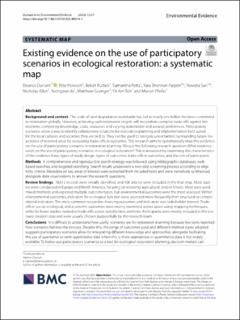| dc.contributor.author | Durrant, Eleanor | |
| dc.contributor.author | Howson, Pete | |
| dc.contributor.author | Puttick, Bekah | |
| dc.contributor.author | Potts, Samantha | |
| dc.contributor.author | Shennan‑Farpón, Yara | |
| dc.contributor.author | Sari, Novieta | |
| dc.contributor.author | Allen, Nicholas | |
| dc.contributor.author | Jo, Yeongeun | |
| dc.contributor.author | Grainger, Matthew | |
| dc.contributor.author | Teh, Yit Arn | |
| dc.contributor.author | Pfeifer, Marion | |
| dc.date.accessioned | 2023-12-12T12:50:21Z | |
| dc.date.available | 2023-12-12T12:50:21Z | |
| dc.date.created | 2023-12-05T16:03:41Z | |
| dc.date.issued | 2023 | |
| dc.identifier.issn | 2047-2382 | |
| dc.identifier.uri | https://hdl.handle.net/11250/3107127 | |
| dc.description.abstract | Background and context The scale of land degradation worldwide has led to nearly one billion hectares committed to restoration globally. However, achieving such restoration targets will necessitate complex trade-offs against limited time, competing knowledge, costs, resources and varying stakeholder and societal preferences. Participatory scenarios allow a way to identify collaborative solutions for restoration planning and implementation best suited for the local cultures and societies they are tied to. They can be used to navigate uncertainties surrounding future trajectories of restored areas by evaluating trade-offs in outcomes. This research aims to systematically map the evidence on the use of participatory scenarios in restoration planning. We use the following research question: What evidence exists on the use of participatory scenarios in ecological restoration? This is answered by examining the characteristics of the evidence base, types of study design, types of outcomes, trade-offs in outcomes, and the role of participants. Methods A comprehensive and reproducible search strategy was followed using bibliographic databases, webbased searches, and targeted searching. Search results underwent a two-step screening process according to eligibility criteria. Metadata on key areas of interest were extracted from included texts and were narratively synthesised alongside data visualisations to answer the research questions. Review findings 18,612 records were initially identified, and 106 articles were included in the final map. Most studies were conducted in Europe and North America, focusing on restoring agricultural land or forests. Most texts used mixed methods and explored multiple outcome types, but environmental outcomes were the most assessed. Within environmental outcomes, indicators for ecological function were assessed more frequently than structural or compositional indicators. The most common reason for choosing outcomes and indicators was stakeholder interest. Tradeoffs in social, ecological, and economic outcomes were mainly examined across space using mapping techniques, while far fewer studies looked at trade-offs across stakeholders and time. Participants were mostly included in the scenario creation step and were usually chosen purposefully by the research team. Conclusions It is difficult to understand how useful scenarios are for restoration planning because few texts reported how scenarios fed into the process. Despite this, the range of outcomes used and different method types adopted suggests participatory scenarios allow for integrating different knowledge and approaches, alongside facilitating the use of qualitative or semi-quantitative data when this is more appropriate or quantitative data is not widely available. To better use participatory scenarios as a tool for ecological restoration planning, decision-makers can push for greater levels and definitions of participation from the offset of restoration projects with specified, regular, and structured communication and participation channels. We also recommend more systematic methods of participant selection, such as stakeholder analysis. Further research is needed to understand the effectiveness of participatory scenarios in restoration planning and whether the participation of stakeholders was successful in meeting objectives. To improve the evidence base, future studies should clearly evaluate their effectiveness in the restoration planning process and their success in meeting their participatory objectives. Evidence synthesis, Stakeholder engagement, Collaboration, Alternative futures, Socioecological systems, Co-production | en_US |
| dc.language.iso | eng | en_US |
| dc.rights | Navngivelse 4.0 Internasjonal | * |
| dc.rights.uri | http://creativecommons.org/licenses/by/4.0/deed.no | * |
| dc.subject | Conservation | en_US |
| dc.subject | Energy transition | en_US |
| dc.subject | Evidence synthesis | en_US |
| dc.subject | Floating solar | en_US |
| dc.subject | Green infrastructure | en_US |
| dc.subject | Ground-mounted photovoltaic | en_US |
| dc.subject | Solar panels | en_US |
| dc.subject | Wildlife | en_US |
| dc.title | Existing evidence on the use of participatory scenarios in ecological restoration: a systematic map | en_US |
| dc.title.alternative | Existing evidence on the use of participatory scenarios in ecological restoration: a systematic map | en_US |
| dc.type | Peer reviewed | en_US |
| dc.type | Journal article | en_US |
| dc.description.version | publishedVersion | en_US |
| dc.rights.holder | © 2023 The Authors | en_US |
| dc.subject.nsi | VDP::Matematikk og Naturvitenskap: 400 | en_US |
| dc.source.volume | 12 | en_US |
| dc.source.journal | Environmental Evidence | en_US |
| dc.identifier.doi | 10.1186/s13750-023-00318-x | |
| dc.identifier.cristin | 2209390 | |
| dc.relation.project | Andre: British Academy | en_US |
| dc.relation.project | EU – Horisont Europa (EC/HEU): HOliFOOD | en_US |
| dc.relation.project | Andre: BBSRC Global Challenges Research Fund | en_US |
| dc.relation.project | EC/H2020/101017857. | en_US |
| dc.relation.project | Andre: Newcastle University IAFRI partnership with FERA Science | en_US |
| dc.relation.project | Egen institusjon: Norwegian institute for nature research (NINA) | en_US |
| dc.relation.project | Andre: Treescapes grant Agroforestry Futures | en_US |
| dc.relation.project | Andre: ONEplanet DTP Natural Environmental Research Council (NERC) | en_US |
| dc.source.articlenumber | 25 | en_US |
| cristin.ispublished | true | |
| cristin.fulltext | original | |
| cristin.qualitycode | 1 | |

